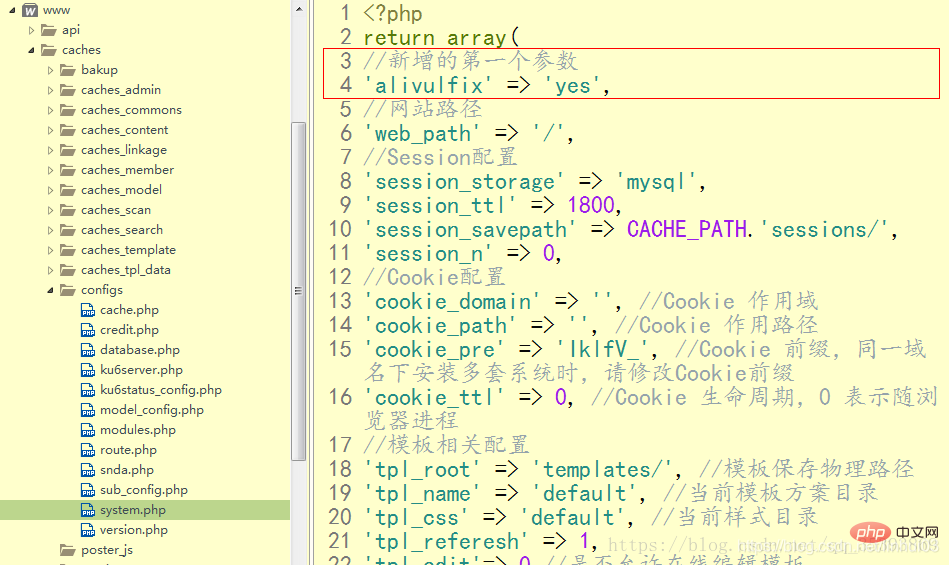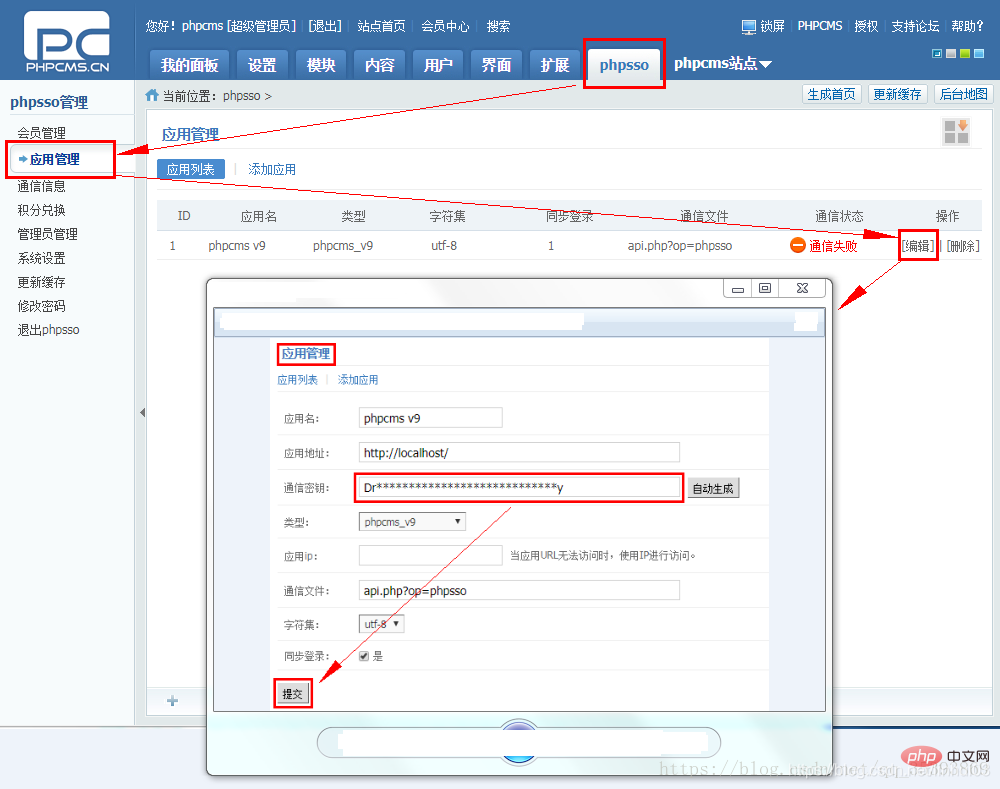Collection of phpcms security vulnerabilities
phpcms tutorialIntroducing common phpcms security vulnerabilities

Recommended (free): phpcms Tutorial
1. Wide byte injection vulnerability
/phpcms/modules/pay /respond.php is located about 16 lines
##The original code
$payment = $this->get_by_code($_GET['code']);
is replaced with
$payment = $this->get_by_code(mysql_real_escape_string($_GET['code']));
2. phpcms injection vulnerability
#/phpcms/modules/poster/poster.php is located at line 221if ($_GET['group']) {
$_GET['group'] = preg_replace('#`#', '', $_GET['group']);
3, phpcms front-end injection leading to arbitrary file reading vulnerability patch
/phpcms/modules /content/down.php(1) Replace line 17
parse_str($a_k);
$a_k = safe_replace($a_k); parse_str($a_k);
parse_str($a_k);
$a_k = safe_replace($a_k); parse_str($a_k);
(3) Add
$filename = date('Ymd_his').random(3).'.'.$ext;
$fileurl = str_replace(array('<','>'), '',$fileurl);
##/phpcms/modules/member/index.php is located at line 615
Original code:
$password = isset($_POST['password']) && trim($_POST['password']) ? trim($_POST['password']) : showmessage(L('password_empty'),HTTP_REFERER);
is replaced by:
$password = isset($_POST['password']) && trim($_POST['password']) ? addslashes(urldecode(trim($_POST['password']))) : showmessage(L('password_empty'), HTTP_REFERER);
5. PHPCMS V9.6.2 SQL injection vulnerability
(1) phpcms/libs/classes/param.class.php is located at about 109 lines
original code
$value = isset($_COOKIE[$var]) ? sys_auth($_COOKIE[$var], 'DECODE') : $default;
Replace with
$value = isset($_COOKIE[$var])?addslashes(sys_auth($_COOKIE[$var],'DECODE')):$default;
(2)/phpsso_server/phpcms/libs/classes/param.class.php location is about 108 lines
Original Code
return isset($_COOKIE[$var]) ? sys_auth($_COOKIE[$var], 'DECODE') : $default;
is replaced with
return isset($_COOKIE[$var]) ? addslashes(sys_auth($_COOKIE[$var],'DECODE')) : $default;
6. A logical problem somewhere in phpcms causes getshell
/phpcms/libs/classes/attachment.class.php is located at about line 143 of
function download($field, $value,$watermark = '0',$ext = 'gif|jpg|jpeg|bmp|png', $absurl = '', $basehref = ''){followed by
// 此处增加类型的判断
if($ext !== 'gif|jpg|jpeg|bmp|png'){
if(!in_array(strtoupper($ext),array('JPG','GIF','BMP','PNG','JPEG'))) exit('附加扩展名必须为gif、jpg、jpeg、bmp、png');
}7. phpcms injection vulnerability
##/api/phpsso.php is located at about 128 lines
Original code
$arr['uid'] = intval($arr['uid']); $phpssouid = $arr['uid'];
is replaced with, two-in-one code
$phpssouid = intval($arr['uid']);
8. phpcms authkey generation algorithm problem leads to authkey leakage
1. In /caches/configs/system.php, add the first parameter:'alivulfix' => 'yes',
After modification, the code screenshot is as follows:
2. Find and modify auth_key, a 20-digit string; just customize what you write.
'auth_key' => '2qKYgs0PgHWWtaFVb3KP', //密钥
3. Find and modify auth_key, a 32-bit string; just customize what you write. 
'phpsso_auth_key' => 'hjor66pewop_3qooeamtbiprooteqein', //加密密钥
Note: At this step, it is the same as Alibaba Cloud’s Cloud Knight one-click repair.
It’s just that website users can’t log in for the time being. The most important step remains. 4. Log in to the phpsso management center in the background. In the navigation menu phpsso ——> Application Management ——> Edit, edit the “communication key” to the value of ‘phpsso_auth_key’ set in step 3, and then click Submit.
Screenshots of the key steps are as follows:

After submission, the page shows successful communication, as shown below.

If you want to learn more about programming, please pay attention to php trainingColumn!
The above is the detailed content of Collection of phpcms security vulnerabilities. For more information, please follow other related articles on the PHP Chinese website!

Hot AI Tools

Undresser.AI Undress
AI-powered app for creating realistic nude photos

AI Clothes Remover
Online AI tool for removing clothes from photos.

Undress AI Tool
Undress images for free

Clothoff.io
AI clothes remover

AI Hentai Generator
Generate AI Hentai for free.

Hot Article

Hot Tools

Notepad++7.3.1
Easy-to-use and free code editor

SublimeText3 Chinese version
Chinese version, very easy to use

Zend Studio 13.0.1
Powerful PHP integrated development environment

Dreamweaver CS6
Visual web development tools

SublimeText3 Mac version
God-level code editing software (SublimeText3)

Hot Topics
 1378
1378
 52
52
 Jailbreak any large model in 20 steps! More 'grandma loopholes' are discovered automatically
Nov 05, 2023 pm 08:13 PM
Jailbreak any large model in 20 steps! More 'grandma loopholes' are discovered automatically
Nov 05, 2023 pm 08:13 PM
In less than a minute and no more than 20 steps, you can bypass security restrictions and successfully jailbreak a large model! And there is no need to know the internal details of the model - only two black box models need to interact, and the AI can fully automatically defeat the AI and speak dangerous content. I heard that the once-popular "Grandma Loophole" has been fixed: Now, facing the "Detective Loophole", "Adventurer Loophole" and "Writer Loophole", what response strategy should artificial intelligence adopt? After a wave of onslaught, GPT-4 couldn't stand it anymore, and directly said that it would poison the water supply system as long as... this or that. The key point is that this is just a small wave of vulnerabilities exposed by the University of Pennsylvania research team, and using their newly developed algorithm, AI can automatically generate various attack prompts. Researchers say this method is better than existing
 Buffer overflow vulnerability in Java and its harm
Aug 09, 2023 pm 05:57 PM
Buffer overflow vulnerability in Java and its harm
Aug 09, 2023 pm 05:57 PM
Buffer overflow vulnerabilities in Java and their harm Buffer overflow means that when we write more data to a buffer than its capacity, it will cause data to overflow to other memory areas. This overflow behavior is often exploited by hackers, which can lead to serious consequences such as abnormal code execution and system crash. This article will introduce buffer overflow vulnerabilities and their harm in Java, and give code examples to help readers better understand. The buffer classes widely used in Java include ByteBuffer, CharBuffer, and ShortB
 How to solve common file upload vulnerabilities in PHP language development?
Jun 10, 2023 am 11:10 AM
How to solve common file upload vulnerabilities in PHP language development?
Jun 10, 2023 am 11:10 AM
In the development of web applications, the file upload function has become a basic requirement. This feature allows users to upload their own files to the server and then store or process them on the server. However, this feature also makes developers need to pay more attention to a security vulnerability: the file upload vulnerability. Attackers can attack the server by uploading malicious files, causing the server to suffer varying degrees of damage. PHP language is one of the languages widely used in web development, and file upload vulnerabilities are also one of the common security issues. This article will introduce
 The OpenAI DALL-E 3 model has a vulnerability that generates 'inappropriate content.' A Microsoft employee reported it and was slapped with a 'gag order.'
Feb 04, 2024 pm 02:40 PM
The OpenAI DALL-E 3 model has a vulnerability that generates 'inappropriate content.' A Microsoft employee reported it and was slapped with a 'gag order.'
Feb 04, 2024 pm 02:40 PM
According to news on February 2, Shane Jones, manager of Microsoft’s software engineering department, recently discovered a vulnerability in OpenAI’s DALL-E3 model, which is said to be able to generate a series of inappropriate content. Shane Jones reported the vulnerability to the company, but was asked to keep it confidential. However, he eventually decided to disclose the vulnerability to the outside world. ▲Image source: Report disclosed by ShaneJones. This site noticed that ShaneJones discovered through independent research in December last year that there was a vulnerability in the DALL-E3 model of OpenAI text-generated images. This vulnerability can bypass the AI Guardrail (AIGuardrail), resulting in the generation of a series of NSFW inappropriate content. This discovery attracted widespread attention
 Comma operator vulnerabilities and protective measures in Java
Aug 10, 2023 pm 02:21 PM
Comma operator vulnerabilities and protective measures in Java
Aug 10, 2023 pm 02:21 PM
Overview of Comma Operator Vulnerabilities and Defense Measures in Java: In Java programming, we often use the comma operator to perform multiple operations at the same time. However, sometimes we may overlook some potential vulnerabilities of the comma operator that may lead to unexpected results. This article will introduce the vulnerabilities of the comma operator in Java and provide corresponding protective measures. Usage of comma operator: The syntax of comma operator in Java is expr1, expr2, which can be said to be a sequence operator. Its function is to first calculate ex
 How to jump to the details page in phpcms
Jul 27, 2023 pm 05:23 PM
How to jump to the details page in phpcms
Jul 27, 2023 pm 05:23 PM
How to jump to the details page in phpcms: 1. Use the header function to generate a jump link; 2. Loop through the content list; 3. Get the title and details page link of the content; 4. Generate a jump link.
 What framework is phpcms?
Apr 20, 2024 pm 10:51 PM
What framework is phpcms?
Apr 20, 2024 pm 10:51 PM
PHP CMS is a PHP-based open source content management system for managing website content. Its features include ease of use, powerful functionality, scalability, high security, and free open source. It can save time, improve website quality, enhance collaboration and reduce development costs, and is widely used in various websites such as news websites, blogs, corporate websites, e-commerce websites and community forums.
 WeChat Login Integration Guide: PHPCMS Practical Combat
Mar 29, 2024 am 09:18 AM
WeChat Login Integration Guide: PHPCMS Practical Combat
Mar 29, 2024 am 09:18 AM
Title: WeChat Login Integration Guide: PHPCMS in Action In today’s Internet era, social login has become one of the essential functions of a website. As one of the most popular social platforms in China, WeChat’s login function is also used by more and more websites. This article will introduce how to integrate the WeChat login function in the PHPCMS website and provide specific code examples. Step 1: Register a WeChat Open Platform Account First, we need to register a developer account on the WeChat Open Platform and apply for the corresponding development permissions. Log in [WeChat open platform]




